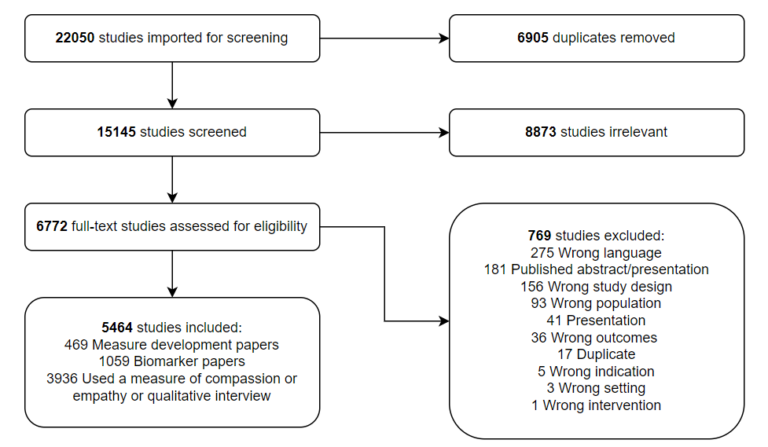Empathy and compassion are crucial to our day to day functioning and relationships. Learning more about how people can be more compassionate and empathic in ways that bolster their own and others' health and well-being is one of hte most important scientific questions of our time.
These constructs can be complex though, and challenging to measure. Advancing the science of compassion and empathy requires that we develop and select measures best suited to answering research questions and evaluating effectiveness of training. This project reviewed surveys and observational/behavioral measures of empathy and compassion published over the last 8 decades. This project was supported by the Sanford Institute for Empathy and Compassion.
Empathy and compassion are related, yet distinct constructs, each of which have multiple dimensions: affective, cognitive, behavioral, intentional, motivational, spiritual, moral, and others. In addition to their multidimensionality, compassion and empathy are crowded by multiple adjacent constrcuts with which they overlap to varying degrees, such as kindness, caring, concern, sensitvity, respect, and a host of behaviors, such as listening, accurately responding, patience and so on. Both compassion and empathy can be conceptualized at state and/or trait levels: people can have context-dependent experiences of empathy or compassion (i.e., state), or can have a tendency to be empathic or compassionate (i.e., trait). Compassion and empathy also appear to differ in underlying structure as well as brain function. When assessing compassion and empathy, it is often important to measure their opposites, or constructs that present barriers to experiencing and expressing compassion or empathy. “Compassion fatigue” is more accurately characterized as empathy fatigue, and some evidence indicates that compassion can actually counteract negative aspects of empathy.
A distinction can be drawn between positive empathy and/or compassion versus over-empathizing, which can lead to what has been termed “compassion fatigue” and burnout
Protects against stress and anxiety
Compassionate love toward self and others is associated with disease outcomes as well, such as increased long-term survival rates in patients with HIV. Self-compassion appears to reduce anxiety, depression, and rumination, and increase psychological well-being and connections with others.
In healthcare professionals, empathy is associated with patient satisfaction, diagnostic accuracy, adherence to treatment recommendations, clinical outcomes, clinical competence, and physician retention.

We identified 503 measures of compassion and empathy. Most measures were developed in the past decade and were self-report scales (412 scales). 53 scales were peer/corollary report measures (a description of the individuals’ thoughts, feelings motives or behaviors) and 38 were behavioral/expert coder measures (someone trained to assess the target’s thoughts, feelings, motives, or behaviors). The number of items of each scale varied from 1 item to 567 items. The average number of items was 32.
Use this interactive data visualization to find measures of empathy and compassion that meet your needs.
Click here or the ⛶ button on the lower right for full-screen (For instructions of how to navigate, please click here):
Please fill out the form below or email info@imagination.ucsd.edu with “Compassion Measures” in the subject line.

Practitioners of the emergent field of Speculative Futures Studies use speculative forms – including, but not limited to, art, literature, and theory- to confront the legacies of imperialism, colonialism, and racism in order to imagine and enact more sustainable and just futures.
Science explains it, but
art may be the key to finding it.
The Speculative Futures Collective seeks to cultivate research with faculty, graduate students, and community members using speculative cultural forms and theories to collaborate on the future of education, ecology, gender, sexuality, and race.

Practitioners of the emergent field of Speculative Futures Studies use speculative forms – including, but not limited to, art, literature, and theory- to confront the legacies of imperialism, colonialism, and racism in order to imagine and enact more sustainable and just futures.
Science explains it, but
art may be the key to finding it.
The Speculative Futures Collective seeks to cultivate research with faculty, graduate students, and community members using speculative cultural forms and theories to collaborate on the future of education, ecology, gender, sexuality, and race.

Unlike intelligence, memory, and creativity, there is an alarming lack of coherent theory and a thin empirical literature on imagination. Why alarming? Imagination may be one of the most important keys to human flourishing and human progress, with spiritual and evolutionary adaptive benefit.
The science of imagination needs a guide for the future.
The Atlas of Imagination is the guide, focusing coherent theoretical models of imagination to drive further investigation and the tools needed for the empirical study of the neurodiversity of imagination.

Unlike intelligence, memory, and creativity, there is an alarming lack of coherent theory and a thin empirical literature on imagination. Why alarming? Imagination may be one of the most important keys to human flourishing and human progress, with spiritual and evolutionary adaptive benefit.
The science of imagination needs
a guide for the future.
The Atlas of Imagination is the guide, focusing coherent theoretical models of imagination to drive further investigation and the tools needed for the empirical study of the neurodiversity of imagination.

The Clarke Center is a research-and-practice hub, where the best insights from the neuroscience of imagination are connected with the latest in technology and put to use to unlock the transformative power of imagination across age groups, and communities to tackle the most pressing issues facing the planet.
Imagination discovers
new possibilities within the impossible.
Imagination is at the root of empathy and compassion. Imagination gives rise to hope. We aim to unleash the power of imagination to tackle the most pressing issues facing life on Earth – to envision and build a more equitable an sustainable world.